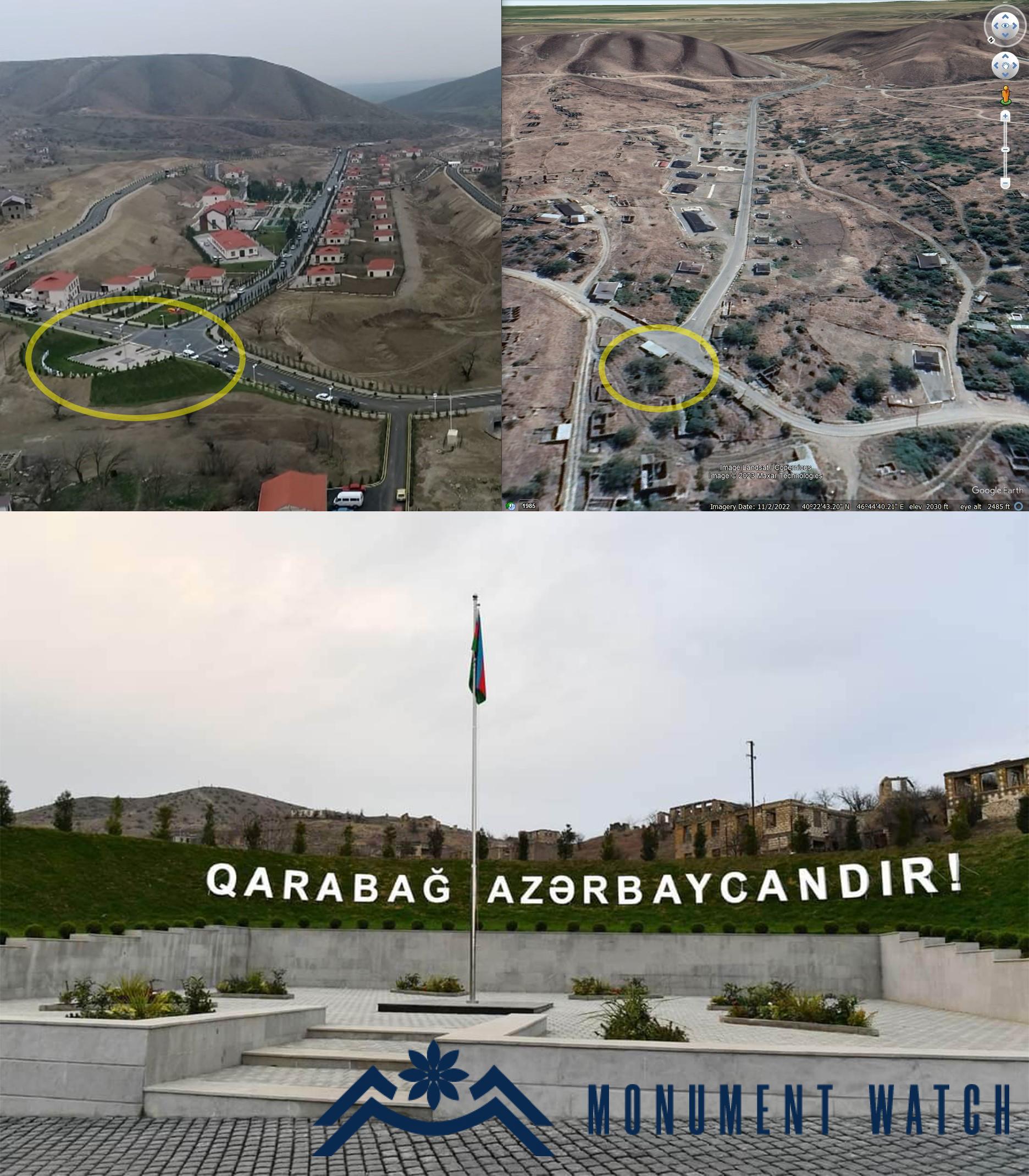Creation of the Azerbaijani settlement of Talish at the cost of the Armenian one
On March 18, 2023, in the occupied Talish village of the Martakert region, the President of Azerbaijan announced the resettlement of 20 Azerbaijani families here. Leaving aside the threats voiced in Aliyev's speech against Armenians, leaving aside the fact that the settling of Azerbaijanis in Talish village is a violation of the provisions of the tripartite declaration signed on November 9, we would like to focus attention to the following picture. It can be seen from the photographs spread via the Internet, that here, on the main road to the village, next to residential houses, a small square was also built, which, judging by the cases with other settlements occupied by Azerbaijanis, is probably a platform for raising the flag. Comparing satellite aerial photographs with the existing image, we can state that it was built on the place of a former residential house, due to its demolition to the ground floor (Fig. 1). Talish is a primordially Armenian settlement with a multi-layered Armenian culture. Here
are the monasteries of Glkhovank or Horekavank, the fortress and estates of the MelikBeglaryans, the church of Surb Astvatsatsin and other monuments. Horekavank Monastery consists of a church, a vestibule, a bell tower, cells of monks located on the western side, and a cemetery (late 13th - early 14th century) (read more: Horekavank (Glkhovank)). Another important monument, located in the village of Talish, is the princely palace, which belonged to the rulers of the Gulistan region Melik-Beglaryans, was built in the 18th century (read more: The fortress and mansion of the Melik-Beglaryans). Talish village is also home for the church of Surb Amenaprkich built in the 19th century. The above-mentioned monuments are also surrounded by other examples of Armenian culture, which indicates that a large Armenian population lived here in different centuries.
The houses destroyed as a result of the "reconstruction" of the village are not the only manifestation of Azerbaijani ethnocide. Combining many videos and photos that appeared on the Internet after the 44-day war, we have already established that the Azerbaijanis destroyed the “Revived Talish” monument, including the village square with many stelae and khachkars (read more: Destruction of the “Revived Talish” monument).
Thus, we see that Azerbaijan is creating an image of a village officially declared at the state level, in which, at the cost of the Armenian heritage, it is building a square with a new look and new symbols.
Our response
The creation of a new Azerbaijani settlement at the cost of the Armenian historical village of the Talish region of Artsakh is a cultural genocide, the purpose of which is to destroy the Armenian trace. The Lemkin Institute for the Prevention of Genocide, as an international independent non-governmental organization, issued 5 warnings to Azerbaijan after the war, considering its actions a genocide. In its statements, the
institute also notes that Artsakh is 99.7% owned by Armenians along with their indivisible cultural heritage (https://www.lemkininstitute.com/red-flag-alerts-1/red-flagalert-for-genocide---azerbaijan-update-4). As for the Azerbaijanization of the territory of Talish village in Artsakh, it should be noted that the historical territory of people of Artsakh is not only a physical unit, it is a culturally rich landscape with its own history, identity, which is the cradle of people of Artsakh, and all its components, each unit is important for the preservation of local culture, identity and future reproduction.
The declaration of historical Talish village as Azerbaijani clearly violates the fundamental principles of cultural identity, historicity, authenticity and integrity of the territory, which follow from the 1994 Nara Document on the authenticity of cultural heritage adopted in Japan (https://www.icomos.org/charters/nara-e.pdf), as well as from the document adopted by ICOMOS New Delhi in 2017 (http://www.icomosisc20c.org/pdf/madrid-new-delhi-document-2017.pdf).
The Nara Document on the Preservation of Authenticity emphasizes that in cases where cultural values appear to be in conflict, respect for cultural diversity demands acknowledgment of the legitimacy of the cultural values of all parties. Azerbaijan, by such actions, flagrantly violates not only the UN Charter, but also a number of provisions of international humanitarian law, universal international human rights. This policy of intentional destruction of cultural heritage is also condemned in the 2003 UNESCO Declaration on the Intentional Destruction of Cultural Heritage.

